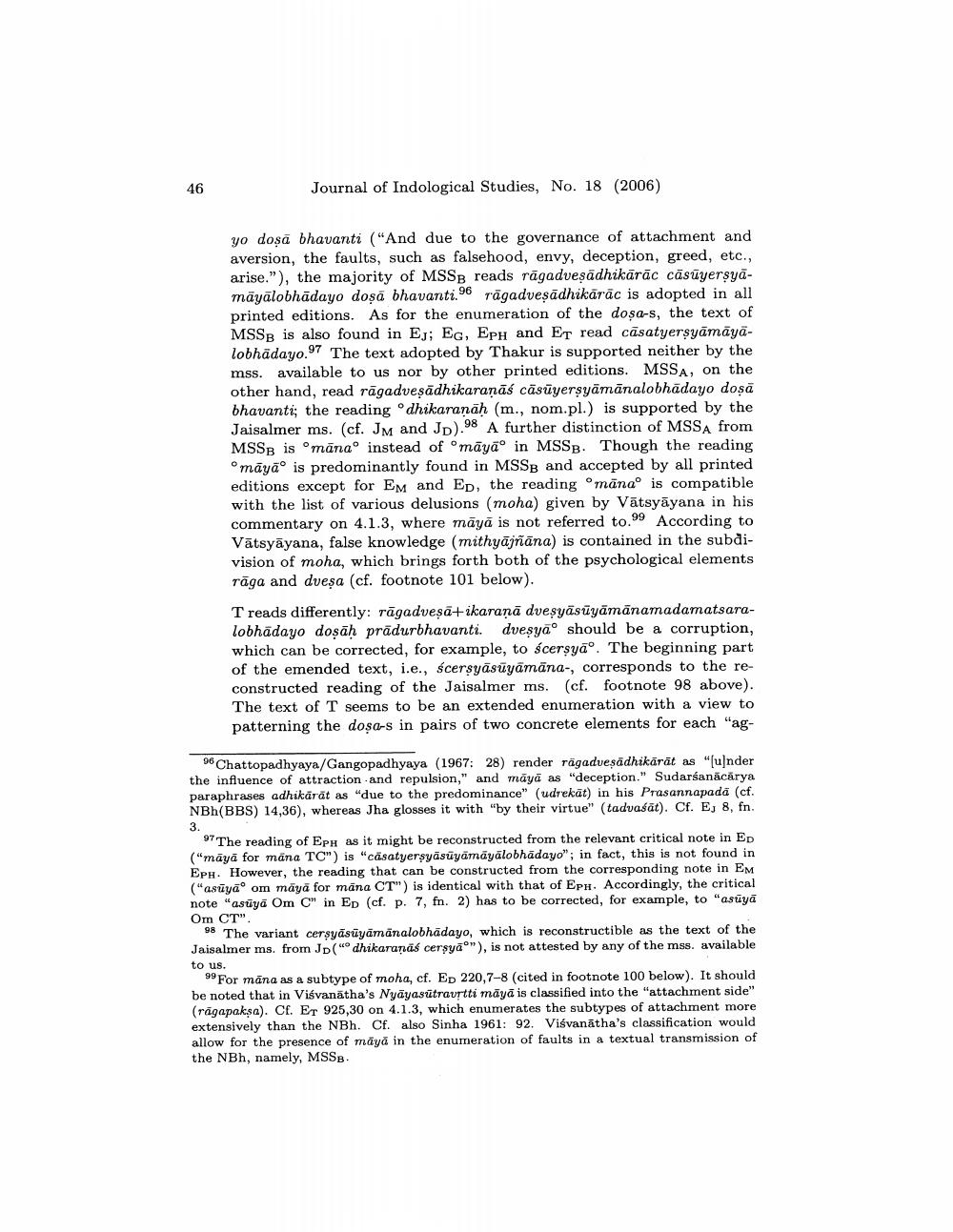________________
Journal of Indological Studies, No. 18 (2006)
yo dosā bhavanti ("And due to the governance of attachment and aversion, the faults, such as falsehood, envy, deception, greed, etc., arise."), the majority of MSSB reads rāgadveşadhikarāc casuyersyamāyālobhādayo doşā bhavanti.96 rāgadveşādhikarāc is adopted in all printed editions. As for the enumeration of the dosa-s, the text of MSSB is also found in EJ; EG, Eph and Er read cāsatyersyāmāyālobhādayo.97 The text adopted by Thakur is supported neither by the mss. available to us nor by other printed editions. MSSA, on the other hand, read rāgadveşādhikaranās cāsüyersyāmānalobhādayo dosa bhavanti; the reading dhikaranāh (m., nom.pl.) is supported by the Jaisalmer ms. (cf. JM and JD).98 A further distinction of MSSA from MSSB is omānao instead of māyao in MSSB. Though the reading omāyā° is predominantly found in MSSB and accepted by all printed editions except for Em and Ed, the reading manao is compatible with the list of various delusions (moha) given by Vātsyāyana in his commentary on 4.1.3, where māyā is not referred to.99 According to Vātsyāyana, false knowledge (mithyājñāna) is contained in the subdivision of moha, which brings forth both of the psychological elements rāga and dveşa (cf. footnote 101 below).
T reads differently: rāgadvesā+ikaranā dvesyāsüyāmānamadamatsaralobhādayo dosāh prādurbhavanti. dvesyao should be a corruption, which can be corrected, for example, to scersyao. The beginning part of the emended text, i.e., Ścersyāsüyāmāna, corresponds to the reconstructed reading of the Jaisalmer ms. (cf. footnote 98 above). The text of T seems to be an extended enumeration with a view to patterning the dosa-s in pairs of two concrete elements for each "ag
Chattopadhyaya/Gangopadhyaya (1967: 28) render rägadvesādhikärät as "[u]nder the influence of attraction and repulsion," and māyā as "deception." Sudarsanācārya paraphrases adhikarät as due to the predominance" (udrekat) in his Prasannapada (cf. NBh(BBS) 14,36), whereas Jha glosses it with "by their virtue" (tadvaśāt). Cf. EJ 8, fn.
3.
97 The reading of Eph as it might be reconstructed from the relevant critical note in Ep ("māyā for mäna TC") is "cäsatyersyāsüyāmāyālobhādayo"; in fact, this is not found in Eph. However, the reading that can be constructed from the corresponding note in EM ("astyao om māyā for māna CT") is identical with that of Eph. Accordingly, the critical note "asūya Om C" in Ep (cf. p. 7, fn. 2) has to be corrected, for example, to "asuyā Om CT"
98 The variant cersyāsüyamanalobhadayo, which is reconstructible as the text of the Jaisalmer ms. from JD(" dhikaranas cersyao"), is not attested by any of the mss. available to us.
For māna as a subtype of moha, cf. Ep 220,7-8 (cited in footnote 100 below). It should be noted that in Visvanatha's Nyāyasútraurtti māyā is classified into the "attachment side" (râgapaksa). Cf. Er 925,30 on 4.1.3, which enumerates the subtypes of attachment more extensively than the NBh. Cf. also Sinha 1961: 92. Visvanātha's classification would allow for the presence of māya in the enumeration of faults in a textual transmission of the NBh, namely, MSSB




